|
|
BAT REMOVAL QUESTIONS
CLICK ON THE PICTURES
BELOW TO VIEW FULL
SIZE
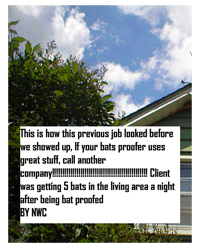 So how do I bat Proof My
home? So how do I bat Proof My
home?
I get asked this question all the time, “is bat proofing
something that
a homeowner can do.” The answer is maybe. Can you work high
up on a
ladder? Do you have all the equipment to work safely on your roof? Most
people aren’t thorough enough to do the job, they will seal
up where
they see the bats coming and going but won’t seal up the
other two
dozen spots that the bats are using. Most homeowners will go down to
the hardware store and buying 6 tubes of the cheapest caulking they can
find or worse yet a can of great stuff and start sealing. At NBWC we use
between 2-25 cases of the best caulking to complete a bat job. All
places that mice or other rodent can chew through we use galvanized
hardware cloth. If you have roof vents 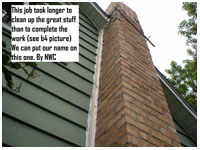
that the
bats can get into
we will install roof vent baskets. If
your masonry chimney needs to be tuck pointed, we can do that. If your
chimney doesn’t have a cap, we will install one. After we
correct all
the flaws in the home we will install our exclusion valves to let the
bat out.
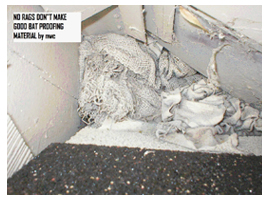
|
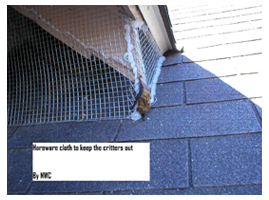 How do I make and
exclusion valve (bat
valve)? How do I make and
exclusion valve (bat
valve)?
A bat valve is a simple device that lets the bats out but they
can’t
get back in. Every bat valve is custom made for each application. Some
bat proofers will use netting put over the holes so the bats can crawl
out under the netting but not back in, some will use one way devices
installed on the home. NBWC uses both methods. Every Bat excluder is
custom made for the flaw the bats are using.
|
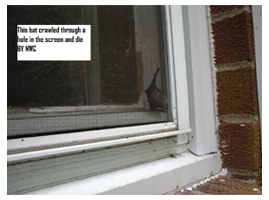 What
will happen if I kill the bats by seal them in? What
will happen if I kill the bats by seal them in?
You would not believe how many times I’m asked this question,
bat are
protected in Minnesota and other states. Most people with bats first
discover that they have bats because they are getting into their home.
If you try to seal them in, three things can happen.
1) They die and you have successfully killed a protected species.
2) They die and now you have a smell in your wall, we call this type of
work search and destroy. We break through the wall board and plaster
looking for the mystery smells. It usually runs 4-10 times more as bat
proofing would have.
3) They find there way out usually through the living area.
|
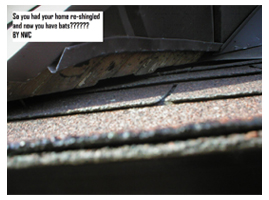 I
just re-roofed and re-sided and now I have bats. Why? I
just re-roofed and re-sided and now I have bats. Why?
Sometimes just by having your home worked on has created new flaws that
the bats can now get into. In Minnesota we have codes on how many layer
of shingles we can put on a home before we have to tear it all off and
start new. So the roofers tore off 2 layers of shingles and put on a
new layer. You now have gaps where your soffit meets the new
roof. Or the roofers re-shingled and told you
didn’t need a new
drip edge.
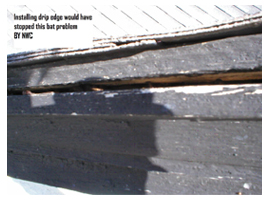 WRONG,
you now have a gap around your entire home that bats, squirrels, or
other rodents can get in. Putting on the cheap roof vent on can also
let the critters in. When you have your home re-roof make sure they
only install bird-proof roof vent. If you are putting on the new style
ridge vent system (cobra vents or other brands) have your roofer
install a narrow piece of hardware cloth before they install the vents.
Yes doing these things will cost a little more money, but by not doing
them it can cost you a lot more. WRONG,
you now have a gap around your entire home that bats, squirrels, or
other rodents can get in. Putting on the cheap roof vent on can also
let the critters in. When you have your home re-roof make sure they
only install bird-proof roof vent. If you are putting on the new style
ridge vent system (cobra vents or other brands) have your roofer
install a narrow piece of hardware cloth before they install the vents.
Yes doing these things will cost a little more money, but by not doing
them it can cost you a lot more.
|
Can I spray some sort of
pesticide or use
other deterrents to get rid of my bats?
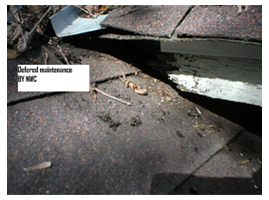 All
pesticides are registered by the USDA, and we have no USDA registered
pesticides or deterrents for bats. The only way to get rid of a bat
colony is to correct the flaws in the structure and evict the bats with
an exclusion device. Do moth balls work? All studies have shown that
they have no effect on bats or any other rodent. I have seen
hundreds of pounds of moth balls put into attics and the only thing
that they keep out is ME.( I don’t like the smell) All
pesticides are registered by the USDA, and we have no USDA registered
pesticides or deterrents for bats. The only way to get rid of a bat
colony is to correct the flaws in the structure and evict the bats with
an exclusion device. Do moth balls work? All studies have shown that
they have no effect on bats or any other rodent. I have seen
hundreds of pounds of moth balls put into attics and the only thing
that they keep out is ME.( I don’t like the smell)
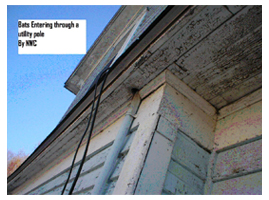
The other thing with moth balls is they have a flash point where they
evaporate and become flammable. NOT A GOOD THING FOR HOT ATTICS.
|
If I install a bat house
will my bats move
to it?
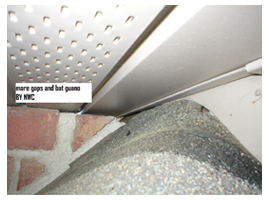 We
have 7 different species of bats in Minnesota; they are broken into 2
different categories, Tree bats and Cave bats. Tree bats migrate every
winter to warmer climates, tree bats live in trees not homes. Cave bats
hibernate in Minnesota and need supplemental heat to survive our
Minnesota winters, cave bats live in homes and other heated structures.
So in Minnesota a bat house is a temporary structure. I always tell
people why would a bat live in a motel 6 when they have a nice home
like yours to live in. Bats have adapted and a home has supplemental
heat loss and cooling loss, it has no predators to bother them. Some of
the old data said that if you have bats to bat proof your home in the
winter after the bats leave. WRONG, the bats have never left; they just
found a warm spot in your home to hibernate. Minnesota has very few
caves left for bats to hibernate in, so they have found something
better. We
have 7 different species of bats in Minnesota; they are broken into 2
different categories, Tree bats and Cave bats. Tree bats migrate every
winter to warmer climates, tree bats live in trees not homes. Cave bats
hibernate in Minnesota and need supplemental heat to survive our
Minnesota winters, cave bats live in homes and other heated structures.
So in Minnesota a bat house is a temporary structure. I always tell
people why would a bat live in a motel 6 when they have a nice home
like yours to live in. Bats have adapted and a home has supplemental
heat loss and cooling loss, it has no predators to bother them. Some of
the old data said that if you have bats to bat proof your home in the
winter after the bats leave. WRONG, the bats have never left; they just
found a warm spot in your home to hibernate. Minnesota has very few
caves left for bats to hibernate in, so they have found something
better.
|
I get an occasional bat in
my home in the
winter, what does this mean?
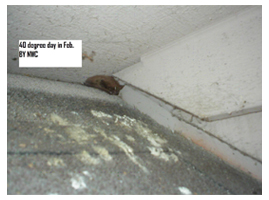 It
means only one thing that you have a colony of bats living in your
home. Bats need a temperature variance of between 32- 49 degrees to
hibernate. When we hit -30 it is too cold for the bats to hibernate and
they wake up and move to a warmer spot (usually your basement), when it
gets +50 I have seen the bats laying on the snow on roofs to stay cool.
The bats need to hibernate to conserve energy to survive our long
winter. When we have winters with very fluctuating temperatures we have
a lot of bats that don’t survive and die. I do a lot of
searching for
dead animals (smells in your home) in the spring thaw. The same thing
happens during our warm summers, the attics get too hot for anything to
survive so they move to a place that is cooler. It
means only one thing that you have a colony of bats living in your
home. Bats need a temperature variance of between 32- 49 degrees to
hibernate. When we hit -30 it is too cold for the bats to hibernate and
they wake up and move to a warmer spot (usually your basement), when it
gets +50 I have seen the bats laying on the snow on roofs to stay cool.
The bats need to hibernate to conserve energy to survive our long
winter. When we have winters with very fluctuating temperatures we have
a lot of bats that don’t survive and die. I do a lot of
searching for
dead animals (smells in your home) in the spring thaw. The same thing
happens during our warm summers, the attics get too hot for anything to
survive so they move to a place that is cooler.
|
I have bats roosting
in my entry way, does this mean I have a colony, is there anything I
can do?
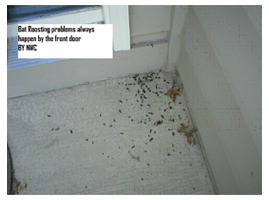 Having
bats in your entry way can be a nuisance. You can try some deterrents
to stop the roosting. What we do at NBWC is to hang a clear sheet of 4
mil plastic from the soffits down the wall at least 1 foot; we attach
the plastic with clear silicone. This keeps the bats from roosting in
this spot, it may move them to another spot and you will have to repeat
the process. Having
bats in your entry way can be a nuisance. You can try some deterrents
to stop the roosting. What we do at NBWC is to hang a clear sheet of 4
mil plastic from the soffits down the wall at least 1 foot; we attach
the plastic with clear silicone. This keeps the bats from roosting in
this spot, it may move them to another spot and you will have to repeat
the process.
Having a bat roost doesn’t mean you have a colony in your
home. If you
enter your attic and find bat guano in your insulation or you have a
spot on your siding that is covered with bat guano, I’d be
concerned
and call NBWC.
|
I get an occasional bat in
the summer time
should I be concerned?
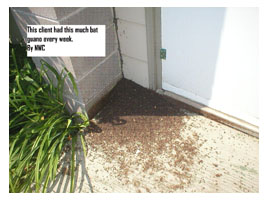 Yes,
you should. I hear the same story at least 5 times a week, where
someone has bat in their living area and they rationalize how it got in
the home “I left the garage door open last night and it must
have come
in the door” or “I was bringing the groceries in
last night the bat has
must have come in then” Most people believe this
rationalizing for a
few years then they realize that they have a bat problem. When I
inspect a home that has had a bat in the living area about 95% of the
time they have a colony living in the home. Yes,
you should. I hear the same story at least 5 times a week, where
someone has bat in their living area and they rationalize how it got in
the home “I left the garage door open last night and it must
have come
in the door” or “I was bringing the groceries in
last night the bat has
must have come in then” Most people believe this
rationalizing for a
few years then they realize that they have a bat problem. When I
inspect a home that has had a bat in the living area about 95% of the
time they have a colony living in the home.
Call 763-227-9888 to schedule an inspection
|
|

